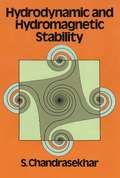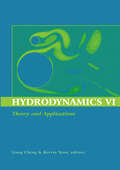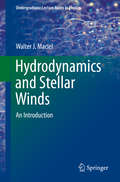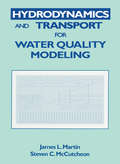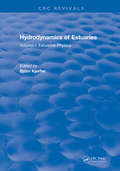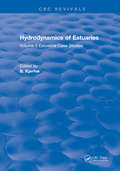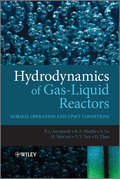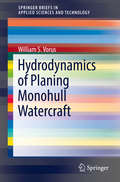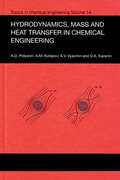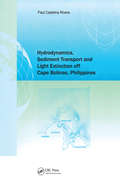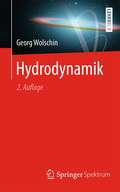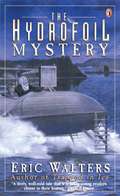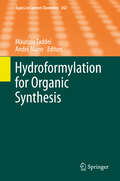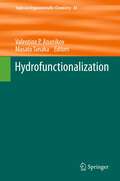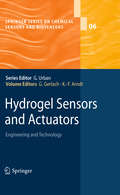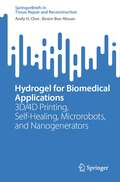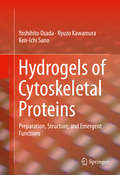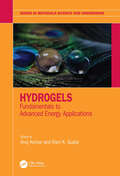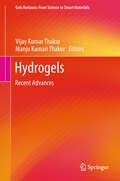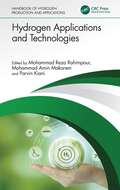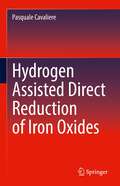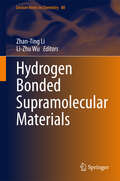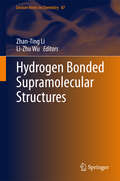- Table View
- List View
Hydrodynamic and Hydromagnetic Stability
by S. ChandrasekharDr. Chandrasekhar's book received high praise when it first appeared in 1961 as part of Oxford University Press' International Series of Monographs on Physics. Since then it has been reprinted numerous times in its expensive hardcover format. This first lower-priced, sturdy paperback edition will be welcomed by graduate physics students and scientists familiar with Dr. Chandrasekhar's work, particularly in light of the resurgence of interest in the Rayleigh-Bénard problem.This book presents a most lucid introduction to the Rayleigh-Bénard problem: it has also been applauded for its thorough, clear coverage of the theory of instabilities causing convection.Dr. Chandrasekhar considers most of the typical problems in hydromagnetic stability, with the exception of viscous shear flow; a specialized domain deserving a book unto itself. Contents include: Rotation; Stability of More General Flows; Bénard Problem; Gravitational Equilibrium and Instability; Stability of a Magnetic Field; Thermal Instability of a Layer of Fluid heated from Below; Rayleigh-Taylor Instability; Kelvin-Helmholtz Instability; and Onset of Thermal Instability in Fluid Spheres and Spherical Shells.Each chapter is accompanied by a section of bibliographical notes: indexes locating definitions and theorems are also provided. Graduate students in theoretical and experimental physics, as well as physicists in diverse fields, will immediately remark upon the clear exposition, and be glad this book is now so readily available.
Hydrodynamics VI: Proceedings of the 6th International Conference on Hydrodynamics, Perth, Western Australia, 24-26 November 2004
by Liang Cheng Kervin YeowThe International Conference on Hydrodynamics is an increasingly important event at which academics, researchers and practitioners can exchange new ideas and their research findings. This volume contains papers from the 2004 conference covering a wide range of subjects within hydrodynamics, including traditional engineering, architectural and mecha
Hydrodynamics and Stellar Winds
by Walter J. MacielIntroduces hydrodynamics to undergraduate students in physics and astrophysics. Stellar winds are a common phenomenon in the life of stars, from the dwarfs like the Sun to the red giants and hot supergiants, constituting one of the basic aspects of modern astrophysics. Stellar winds are a hydrodynamic phenomenon in which circumstellar gases expand towards the interstellar medium. This book presents an elementary introduction to the fundamentals of hydrodynamics with an application to the study of stellar winds. The principles of hydrodynamics have many other applications, so that the book can be used as an introduction to hydrodynamics for students of physics, astrophysics and other related areas.
Hydrodynamics and Transport for Water Quality Modeling
by James L. Martin Steven C. McCutcheonHydrodynamics and Transport for Water Quality Modeling presents a complete overview of current methods used to describe or predict transport in aquatic systems, with special emphasis on water quality modeling. The book features detailed descriptions of each method, supported by sample applications and case studies drawn from the authors' years of experience in the field. Each chapter examines a variety of modeling approaches, from simple to complex. This unique text/reference offers a wealth of information previously unavailable from a single source.The book begins with an overview of basic principles, and an introduction to the measurement and analysis of flow. The following section focuses on rivers and streams, including model complexity and data requirements, methods for estimating mixing, hydrologic routing methods, and unsteady flow modeling. The third section considers lakes and reservoirs, and discusses stratification and temperature modeling, mixing methods, reservoir routing and water balances, and dynamic modeling using one-, two-, and three-dimensional models. The book concludes with a section on estuaries, containing topics such as origins and classification, tides, mixing methods, tidally averaged estuary models, and dynamic modeling. Over 250 figures support the text.This is a valuable guide for students and practicing modelers who do not have extensive backgrounds in fluid dynamics.
Hydrodynamics of Estuaries: Volume I Estuarine Physics
by B. KjerfveThese books are divided into two volumes. The first focuses on estuarine physics and physical processes and interpretations. I have, for the most parts, intentionally downplayed engineering applications to estuaries. It is my bias that a deeper understanding is accomplished with a physical approach, whereas an engineering approach is largely geared toward finding a solution to a problem. Of course, it is not always easy to make this distinction. The second volume is a presentation of physical case studies of several important estuaries, spanning the major geomorphic types. I believe that it can be very useful to all areas of the world. I have consciously strived to be more international to scope in selection of both authors and estuarine case studies.
Hydrodynamics of Estuaries: Volume II Estuarine Case Studies
by B. KjerfveThese books are divided into two volumes. The first focuses on estuarine physics and physical processes and interpretations. I have, for the most parts, intentionally downplayed engineering applications to estuaries. It is my bias that a deeper understanding is accomplished with a physical approach, whereas an engineering approach is largely geared toward finding a solution to a problem. Of course, it is not always easy to make this distinction. The second volume is a presentation of physical case studies of several important estuaries, spanning the major geomorphic types. I believe that it can be very useful to all areas of the world. I have consciously strived to be more international to scope in selection of both authors and estuarine case studies.
Hydrodynamics of Gas-Liquid Reactors
by Y. Yan Simon Lo Donglin Zhao R. F. Mudde H. Morvan Barry AzzopardiThe design of chemical reactors and their safety are as critical to the success of a chemical process as the actual chemistry taking place within the reactor. This book provides a comprehensive overview of the practical aspects of multiphase reactor design and operation with an emphasis on safety and clean technology. It considers not only standard operation conditions, but also the problems of runaway reaction conditions and protection against ensuing over-pressure.Hydrodynamics of Multiphase Reactors addresses both practical and theoretical aspects of this topic. Initial chapters discuss various different types of gas/liquid reactors from a practical viewpoint, and later chapters focus on the modelling of multiphase systems and computational methods for reactor design and problem solving. The material is written by experts in their specific fields and will include chapters on the following topics: Multiphase flow, Bubble columns, Sparged stirred vessels, Macroscale modelling, Microscale modelling, Runaway conditions, Behaviour of vessel contents, Choked flow, Measurement techniques.
Hydrodynamics of High-Speed Marine Vehicles
by Odd M. FaltinsenHydrodynamics of High-Speed Marine Vehicles discusses the three main categories of high-speed marine vehicles - vessels supported by submerged hulls, air cushions or foils. The wave environment, resistance, propulsion, seakeeping, sea loads and manoeuvring are extensively covered based on rational and simplified methods. Links to automatic control and structural mechanics are emphasized. A detailed description of waterjet propulsion is given and the effect of water depth on wash, resistance, sinkage and trim is discussed. Chapter topics include resistance and wash; slamming; air cushion-supported vessels, including a detailed discussion of wave-excited resonant oscillations in air cushion; and hydrofoil vessels. The book contains numerous illustrations, examples and exercises.
Hydrodynamics of Planing Monohull Watercraft
by William S. VorusThis book addresses the principles involved in the design and engineering of planing monohull power boats, with an emphasis on the theoretical fundamentals that readers need in order to be fully functional in marine design and engineering. Author William Vorus focuses on three topics: boat resistance, seaway response, and propulsion and explains the physical principles, mathematical details, and theoretical details that support physical understanding. In particular, he explains the approximations and simplifications in mathematics that lead to success in the applications of planing craft design engineering, and begins with the simplest configuration that embodies the basic physics. He leads readers, step-by-step, through the physical complications that occur, leading to a useful working knowledge of marine design and engineering. Included in the book are a wealth of examples that exemplify some of the most important naval architecture and marine engineering problems that challenge many of today's engineers.
Hydrodynamics, Mass and Heat Transfer in Chemical Engineering
by Andrei D. Polyanin A.M. Kutepov D.A. Kazenin A.V. VyazminHydrodynamics, Mass and Heat Transfer in Chemical Engineering contains a concise and systematic exposition of fundamental problems of hydrodynamics, heat and mass transfer, and physicochemical hydrodynamics, which constitute the theoretical basis of chemical engineering in science. Areas covered include: fluid flows; processes of chemical engineeri
Hydrodynamics, Sediment Transport and Light Extinction Off Cape Bolinao, Philippines
by Paul Cadelina RiveraObservational and numerical modelling studies of the hydrodynamics, sediment transport, and light extinction were undertaken in the marine environment around Cape Bolinao in the Lingayen Gulf (NW Philippines). This text reports on the results of these studies, and offers conclusions.
Hydrodynamik
by Georg WolschinDieses Buch stellt ausgehend von der Kontinuitätsgleichung, den Eulergleichungen und der Adiabatengleichung zunächst die Hydrodynamik idealer Fluide dar. Die Behandlung von viskosen Fluiden und den entsprechend modifizierten Grundgleichungen erfolgt über die Navier-Stokes-Gleichungen und die Wärmetransportgleichung, welche die Energiedissipation in realen Fluiden beschreiben. Außerdem werden Diffusionsprozesse in inhomogenen Fluiden und bei der Brown’schen Bewegung untersucht. Diffusion spielt auch bei der Teilchenerzeugung in relativistischen Kollisionen von Bleikernen am LHC eine wichtige Rolle. Eine Lorentz-invariante relativistische Formulierung der Hydrodynamik wird ebenfalls präsentiert. Kapitel über Anwendungen der Hydrodynamik in der Astrophysik und auf Superfluide wie Helium bei tiefen Temperaturen runden diese Einführung in ein breites und modernes Forschungsgebiet ab. Die Neuauflage enthält zusätzlich ein Kapitel über nichtlineare Diffusionsprozesse in fermionischen und bosonischen Systemen mit ihrer Anwendung auf die Bildung von Bose-Einstein-Kondensaten bei niedrigen Energien und Temperaturen sowie auf die lokale Equilibrierung von Quarks und Gluonen in Schwerionenkollisionen bei hohen relativistischen Energien. Testaufgaben am Ende des Buchs motivieren den Leser, sich den Stoff aktiv anzueignen. Der Autor liefert mit diesem Werk eine kurze Einführung für Physikstudierende in die Hydrodynamik. Doch auch Promovierende und Wissenschaftler finden in den fortgeschrittenen Teilen eine gute Hinführung zu aktuellen Forschungsfragestellungen.
Hydroelectric Energy: Renewable Energy and the Environment
by Bikash Pandey Ajoy KarkiProviding essential theory and useful practical techniques for implementing hydroelectric projects, this book outlines the resources, power generation technologies, applications, and strengths and weaknesses for hydroelectric technologies. Emphasizing the links between energy and the environment, it serves as a useful background resource and facilitates decision-making regarding which renewable energy technology works best for different types of applications and regions. Including examples, real-world case studies, and lessons learned, each chapter contains exercise questions, references, and ample photographs and technical drawings from actual micro hydropower plants.
Hydrofoil Mystery
by Eric WaltersIt is 1915 and thirteen-year old William is sent by his mother to spend the summer working with an eccentric inventor, Alexander Graham Bell, and his crew in a tiny Nova Scotia town. They are hard at work designing and building a hydrofoil boat that they hope will help the Allies defend themselves from the German U-boats that are sinking ships and threatening coastal towns during the war. But the sleeping village life William thinks he has been sentenced to turns out to be something quite different as the young boy finds himself embroiled in a deadly mystery that is plaguing the hydrofoil and its builders.
Hydroformylation for Organic Synthesis
by Maurizio Taddei André MannThe Role of Metals and Ligands in Organic Hydroformylation, by Luca Gonsalvi, Antonella Guerriero, Eric Monflier, Frédéric Hapiot, Maurizio Peruzzini. Hydroformylation in Aqueous Biphasic Media Assisted by Molecular Receptors, by Frédéric Hapiot, Hervé Bricout, Sébastien Tilloy, Eric Monflier. Asymmetric Hydroformylation, by Bernabé F. Perandones, Cyril Godard, Carmen Claver. Domino Reactions Triggered by Hydroformylation, by Elena Petricci, Elena Cini. Rhodium-Catalyzed Hydroformylation in Fused Azapolycycles Synthesis, by Roberta Settambolo. Hydroformylation in Natural Product Synthesis, by Roderick W. Bates, Sivarajan Kasinathan.
Hydrofunctionalization
by Masato Tanaka Valentine P. AnanikovValentine P. Ananikov, Irina P. Beletskaya: Alkyne and alkene insertion into metal-heteroatom and metal-hydrogen bonds - the key stages of hydrofunctionalization process.- Akihiko Ishii* and Norio Nakata: The Mechanism for Transition Metal-Catalyzed Hydrochalcogenation of Unsaturated Organic Molecules.- A. L. Reznichenko and Kai C. Hultzsch: Early Transition Metal (Group 3-5, Lanthanides and Actinides) and Main Group Metal (Group 1, 2, and 13) Catalyzed Hydroamination.- Naoko Nishina and Yoshinori Yamamoto: Late transition metal catalyzed hydroamination.- Sumod A. Pullarkat and Pak-Hing Leung: Chiral Metal Complex Promoted Asymmetric Hydrophosphinations.- Masato Tanaka: Recent Progress in Transition Metal-Catalyzed Addition Reactions of H-P(O) Compounds with Unsaturated Carbon Linkages.- Christian Bruneau: Group 8 metals-catalyzed O-H bond addition to unsaturated molecules.- Giorgio Abbiati, Egle M. Beccalli, Elisabetta Rossi: Groups 9 and 10 metals-catalyzed O-H bond addition to unsaturated molecules.- Núria Huguet and Antonio M. Echavarren: Gold-Catalyzed O-H Bond Addition to Unsaturated Organic Molecules.- Akiya Ogawa: Transition-Metal-Catalyzed S-H and Se-H Bonds Addition to Unsaturated Molecules.
Hydrogel Sensors and Actuators
by Gerald Gerlach K. F. ArndtHydrogels are a fascinating class of polymers which show an immense ability of swelling under the influence of temperature, pH value or concentrations of different species in aqueous solutions. The volume change can amount up to several hundred percent. This unique behaviour is already used in such applications like disposable diapers, contact lenses or drug-delivery systems. The ability to perform mechanical work has been shifted the technical interest more and more towards sensors and actuators exploiting the thermo-chemo-mechano-electrical coupling within hydrogels. The accuracy requirements for such devices are much more demanding than for previous applications. Therefore, a deep knowledge of both the material and the functional properties of hydrogel sensors and actuators is needed. The monograph describes state of the art and recent developments for these materials in sensor and actuator technology.
Hydrogel for Biomedical Applications: 3D/4D Printing, Self-Healing, Microrobots, and Nanogenerators (Tissue Repair and Reconstruction)
by Besim Ben-Nissan Andy H. ChoiThis book highlights the latest clinical research and advancements in 3D (bio)printing and 4D printing using stimulus-responsive hydrogels as well as the concept of self-healing and its amalgamation with 3D printed injectable cell-laden tissue constructs. It also explores the use of metal-free “click” chemistry and enzymes such as horseradish peroxidase, hematin, tyrosinase, and transglutaminase to obtain chemically crosslinked hydrogels and the in vitro and in vivo responses. Lastly, the book briefly examines the future of drug delivery and the potentials offered by microrobotics and self-powered devices based on triboelectric nanogenerators. This book caters to biomedical researchers and clinical practitioners working in tissue reconstruction and drug/therapeutic delivery.
Hydrogels of Cytoskeletal Proteins
by Yoshihito Osada Ryuzo Kawamura Ken-Ichi SanoThis book describes a new family of bio-polymergels made from cytoskeletal proteins - actin, microtubule, andtropomyosin. The importance of the gelstate with multi-scale hierarchical structure is emphasized to utilize emergentfunctions in living organisms. Detailed protocol of gel preparation, specifiedmethod of structure investigation, and dynamic studies of self-organization,self-healing, synchronized oscillating, and autonomous motility functions areintroduced together with biomimeticfunctions of synthetic hydrogels.
Hydrogels: Fundamentals to Advanced Energy Applications (Series in Materials Science and Engineering)
by Anuj Kumar and Ram K. GuptaThe demand for advanced energy devices such as high-performance batteries, supercapacitors, fuel cells, electrolyzers, and flexible/wearable devices is increasing rapidly. To meet such demand, high-performance and stable materials that could be used as active materials in these devices are much needed. This book focuses on the use of hydrogels in such emerging applications. The main objective of this book is to provide current, state-of-the-art development in hydrogel-based materials, their applications in energy, and their future challenges. This book covers the entire spectrum of hydrogels for their applications in a range of energy devices in terms of materials, various synthetic approaches, architectural aspects, design and technology of energy devices, and challenges. This book covers the fundamentals of hydrogels, various composites of hydrogels, design concepts, different technologies, and applications in the diverse energy area. All chapters are written by experts in these areas around the world, making this a suitable textbook for students and providing new guidelines to researchers and industries working in these areas. This book includes topics such as various approaches to synthesizing hydrogels, their characterizations, and emerging applications in the energy area. Fundamentals of energy devices, working principles, and their challenges are also covered. This book will provide new directions to scientists, researchers, and students to better understand hydrogel-based materials and their emerging applications in energy.
Hydrogels: Recent Advances (Gels Horizons: From Science to Smart Materials)
by Vijay Kumar Thakur Manju Kumari ThakurThis book discusses recent advances in hydrogels, including their generation and applications and presents a compendium of fundamental concepts. It highlights the most important hydrogel materials, including physical hydrogels, chemical hydrogels, and nanohydrogels and explores the development of hydrogel-based novel materials that respond to external stimuli, such as temperature, pressure, pH, light, biochemicals or magnetism, which represent a new class of intelligent materials. With their multiple cooperative functions, hydrogel-based materials exhibit different potential applications ranging from biomedical engineering to water purification systems. This book covers key topics including superabsorbent polymer hydrogel; intelligent hydrogels for drug delivery; hydrogels from catechol-conjugated materials; nanomaterials loaded hydrogel; electrospinning of hydrogels; biopolymers-based hydrogels; injectable hydrogels; interpenetrating-polymer-network hydrogels: radiation- and sonochemical synthesis of micro/nano/macroscopic hydrogels; DNA-based hydrogels; and multifunctional applications of hydrogels. It will prove a valuable resource for researchers working in industry and academia alike.
Hydrogen Applications and Technologies
by Mohammad Reza Rahimpour Mohammad Amin Makarem Parvin KianiHydrogen has wide applications across many industries, including petroleum refineries, hydrotreating processes, and metallurgy applications. In addition, a number of valuable chemicals, such as ammonia, alcohols, and acids, are manufactured directly or indirectly with hydrogen. Hydrogen Applications and Technologies covers the utilization of hydrogen in petrochemical products, vehicles, and power generation systems, as well as in refinery hydrotreating, metallurgy, welding, annealing, and the heat‑treating of metals. Describes the application of hydrogen in producing valuable chemicals in detail Comprehensively discusses hydrogen utilization as an energy source Covers the application of hydrogen in power generation systems and across various industries Reviews hydrogen’s role as an agent in chemical reactions Part of the multivolume Handbook of Hydrogen Production and Applications, this stand-alone book guides researchers and academics in chemical, environmental, energy, and related areas of engineering interested in development and implementation of hydrogen production technologies.
Hydrogen Assisted Direct Reduction of Iron Oxides
by Pasquale CavaliereThe book describes the main approaches to produce and synthesize iron and steel through hydrogen-based technologies. Depending on the processing route and on the energy demand, the best available techniques and the most forward-looking solutions are explained. The book is edited with the contribution representing a range of industries in order to evaluate the industrial feasibility of each selected technology. It presents the most efficient solutions applied by ironmaking and steelmaking factories all around the world.
Hydrogen Bonded Supramolecular Materials
by Zhan-Ting Li Li-Zhu WuThis book is an up-to-date text covering topics in utilizing hydrogen bonding for constructing functional architectures and supramolecular materials. The first chapter addresses the control of photo-induced electron and energy transfer. The second chapter summarizes the formation of nano-porous materials. The following two chapters introduce self-assembled gels, many of which exhibit unique functions. Other chapters cover the advances in supramolecular liquid crystals and the versatility of hydrogen bonding in tuning/improving the properties and performance of materials. This book is designed to bring together in a single volume the most important and active fields of hydrogen bonding strategy for designing supramolecular materials. The book will be a valuable resource for graduates and researchers working in the fields of supramolecular chemistry and materials sciences. Zhan-Ting Li, PhD, is a Professor of Organic Chemistry at the Department of Chemistry, Fudan University, China Li-Zhu Wu, PhD, is a Professor of Organic Chemistry at the Technical Institute of Physics and Chemistry, Chinese Academy of Sciences, China
Hydrogen Bonded Supramolecular Structures
by Zhan-Ting Li Li-Zhu WuThis book covers the advances in the studies of hydrogen-bonding-driven supramolecular systems made over the past decade. It is divided into four parts, with the first introducing the basics of hydrogen bonding and important hydrogen bonding patterns in solution as well as in the solid state. The second part covers molecular recognition and supramolecular structures driven by hydrogen bonding. The third part introduces the formation of hollow and giant macrocycles directed by hydrogen bonding, while the last part summarizes hydrogen bonded supramolecular polymers. This book is designed to bring together in a single volume the many important aspects of hydrogen bonding supramolecular chemistry and will be a valuable resource for graduates and researchers working in supramolecular and related sciences. Zhan-Ting Li, PhD, is a Professor of Organic Chemistry at the Department of Chemistry, Fudan University, China. Li-Zhu Wu, PhD, is a Professor of Organic Chemistry at the Technical Institute of Physics and Chemistry, Chinese Academy of Sciences, China.
